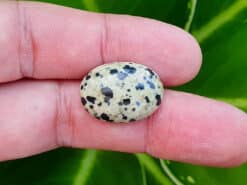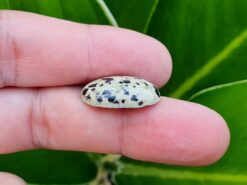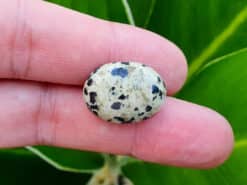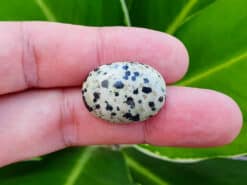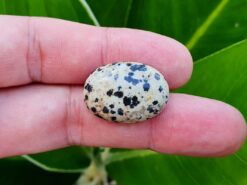Dalmatian stone
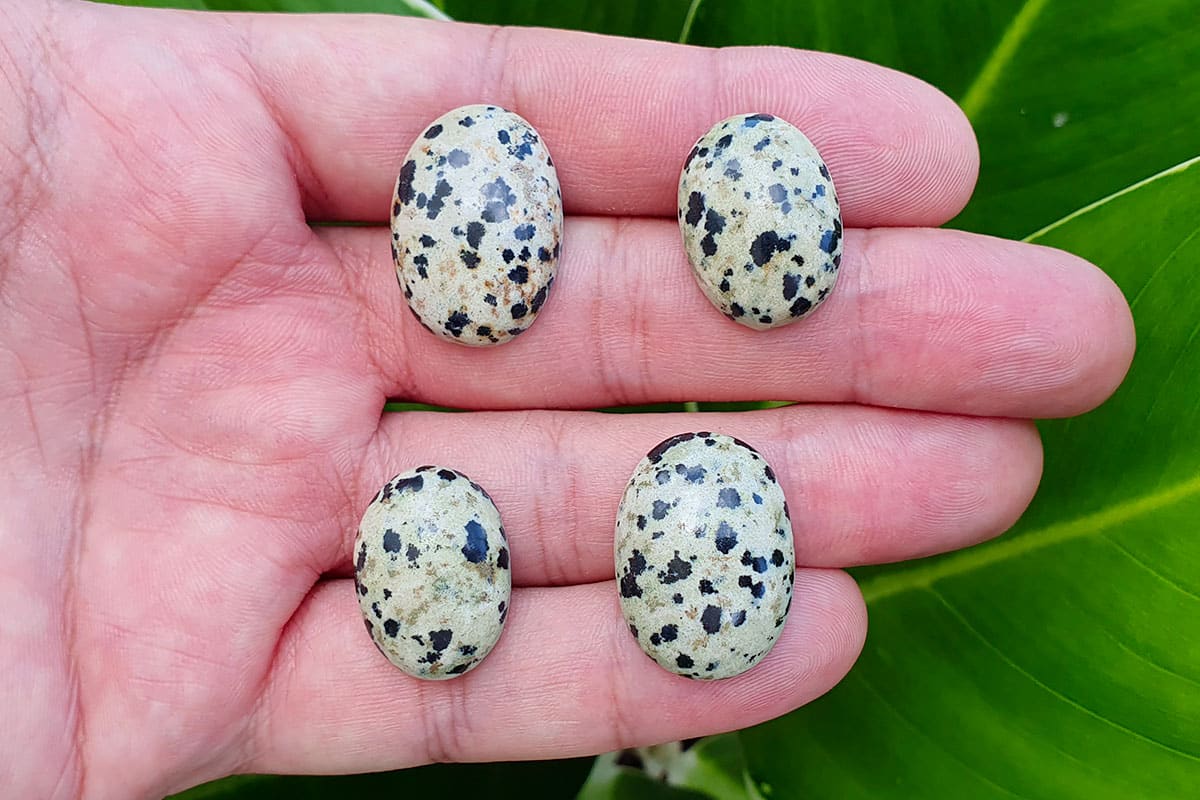
Dalmatian Stone Introduction
A Glimpse into Dalmatian Stone
Dalmatian stone is an instantly recognizable gemstone due to its striking pattern of black and brown spots set against a lighter background, evoking the coat of the famous Dalmatian dog breed. This spotted gem captures attention with its playful, speckled appearance and has become increasingly popular for use in both jewelry and decorative objects. Enthusiasts appreciate its unique look, and artisans often choose dalmatian stone for pieces that aim to convey a sense of fun and originality.
Visually, dalmatian stone offers a strong contrast between the pale or beige base color and the darker patches that dot its surface. This bold pattern makes each stone distinctive, as no two specimens will have the exact same arrangement of spots. Dalmatian stone often appears as polished cabochons, tumbled stones, beads, or even carved figurines. Beyond its aesthetic appeal, some people are drawn to the dalmatian stone meaning in metaphysical circles, which commonly associates it with positivity, grounding, and playful energy.
Why Dalmatian Stone Stands Out
Dalmatian stone stands out primarily for its mottled, high-contrast pattern that immediately distinguishes it from more uniform gemstones. The interplay of dark spots on a lighter matrix lends the stone a vivacious, lively quality, making it a favorite among collectors, jewelry designers, and crystal enthusiasts. Thanks to its unique coloration, dalmatian stone has become a notable member of the decorative stone family, often cherished for its ability to spark conversation and draw the eye.
The History and Origins of Dalmatian Stone
Early Discoveries and Anecdotes
The discovery of dalmatian stone can be traced back to geological explorations in regions known for their volcanic and sedimentary formations. While not as historically renowned as diamonds or rubies, dalmatian stone quickly caught the attention of mineral enthusiasts and casual collectors alike due to its whimsical spotted appearance. Early anecdotes speak of gem hunters and hobbyists who stumbled upon this black-and-brown speckled stone and were fascinated by its resemblance to a Dalmatian dog’s coat.
In some local tales, prospectors recount how the stone’s peculiar pattern set it apart from the surrounding rocks, prompting them to investigate and eventually identify it as a unique ornamental gem. When showcased at mineral fairs and gem shows, dalmatian stone aroused curiosity among onlookers, who often asked whether those spots were natural or artificially imposed. This initial intrigue paved the way for dalmatian stone’s rise as a favorite among those seeking something out of the ordinary for their collections.
Over time, dalmatian stone gained popularity not only for personal collections but also in jewelry-making circles, where its playful motif offered a refreshing alternative to monotone gems. Small-scale artisans and larger jewelry brands alike began incorporating dalmatian stone into their product lines, particularly in cabochon pendants and bead bracelets. Its distinctive spotted pattern quickly established it as a conversation piece, enhancing its desirability among those who value originality.
While many gemstones boast centuries or even millennia of recorded history, dalmatian stone’s journey is a bit more modern in comparison. Nonetheless, it has made its mark as a sought-after stone. Local economies in certain mining areas experienced temporary booms when demand for dalmatian stone spiked, as more suppliers and retailers recognized the stone’s unique potential in the global gem market.
Legendary Sources
Dalmatian stone is predominantly found in specific regions of the world with distinct geological formations conducive to the stone’s formation. While sources have sometimes shifted over the years, certain areas have remained notably productive. The best-quality black-and-brown speckled stone often comes from places where the stone’s contrast is most pronounced—these deposits yield particularly crisp black or brown spots against a pale backdrop.
Sample from Chihuahua, Mexico
Dalmatian stone Meaning and Symbolism
Cultural Significance
Across various cultures, dalmatian stone has been interpreted as a symbol of positivity, protection, and a lighthearted approach to life. The playful pattern—dark spots on a lighter field—is often seen as a nod to spontaneity and optimism. Some believe that dalmatian stone fosters a sense of childlike joy, making it a popular choice for those who want to counterbalance stress or negativity in their daily routines.
Moreover, the dalmatian stone meaning can extend to ideas of grounding and self-reflection. The darker patches scattered across the stone’s surface are sometimes viewed as representations of life’s challenges, while the lighter background signifies the potential for hope and balance. By wearing or carrying dalmatian stone, individuals might feel encouraged to embrace their playful side and remain emotionally centered, even during difficult times.
Traditional Beliefs
While not as widely documented in ancient lore as some other gemstones, dalmatian stone still garners its share of folklore in certain regions. In some communities, it is said to promote loyalty and teamwork, reflecting the nature of the Dalmatian dog breed itself. This notion underscores trust, partnership, and a willingness to support one another.
Folklore related to dalmatian stone may also highlight protective qualities. According to some accounts, travelers would carry a piece of this spotted gem to ward off misfortune on their journeys. Over time, the stone’s reputation for fostering emotional resilience gained traction, often leading people to gift dalmatian stone jewelry to friends and family as a token of love and guardianship.
The Unique Properties of Dalmatian Stone
Physical and Chemical Details
Dalmatian stone is a polymineralic rock, meaning it comprises multiple minerals that combine to create its distinctive appearance. It primarily features feldspar, quartz, and various darker minerals like amphibole or pyroxene, which form the characteristic spotting. On the Mohs hardness scale, dalmatian stone typically ranges from about 5.5 to 7, making it reasonably durable for everyday wear in jewelry, though care is advised to avoid impact or abrasive contact.
The most striking quality of dalmatian stone is, of course, its spotted pattern. Its base color may span from off-white or light gray to a soft beige hue, peppered with black and brown inclusions. These spots can vary in size, density, and shape, rendering each stone one of a kind. Although dalmatian stone does not often display dramatic optical effects like chatoyancy or opalescence, collectors prize its aesthetic uniqueness above all else.
From a gemological standpoint, it’s vital to note that dalmatian stone is not a single mineral species but rather a composite rock. This composition explains why certain specimens might appear slightly different in color or pattern density. Small flecks of iron oxides or other minerals can also influence the stone’s final appearance, adding nuances to the black and brown speckles. Because each stone’s makeup can vary, buyers seeking the best quality should look for crisp contrasts between the background hue and the darker patches.
In terms of density, dalmatian stone is comfortable to wear, neither too heavy nor too light, making it ideal for crafting earrings, bracelets, and pendants. For anyone wanting to confirm authenticity, a gemological lab report can provide peace of mind, verifying the stone’s composition and ruling out any synthetic or dyed imitations.
Extraordinary Phenomena
Unlike gemstones famed for their optical phenomena—like the shimmering cat’s eye effect or vibrant fluorescence—dalmatian stone typically does not exhibit any such spectacular occurrences. Its charm lies primarily in its reliably unique speckled pattern.
However, some collectors may find themselves drawn to specimens with exceptionally large, bold spots or particularly unusual distributions of black and brown patches. In some cases, these variants offer a mesmerizing, marbled appearance. While they do not qualify as “optical phenomena,” they can nonetheless be intriguing enough to command special attention in a collection.
Types (or Colors) of Dalmatian Stone
Exploring dalmatian stone Varieties
Unlike stones that come in an array of starkly different colors, dalmatian stone largely sticks to a consistent palette of light-toned backgrounds complemented by black and brown spots. However, subtle variations do exist. Some specimens lean more toward a cream or beige background, whereas others may appear slightly grayish or even tinged with faint yellow.
Though these differences may be slight, they can influence how the stone is classified in terms of quality and desirability. Generally, dalmatian stone with strong contrast—meaning a lighter base and distinctly dark spots—is deemed more visually appealing. The balance of spot distribution also plays a role in valuation; some collectors prefer a dense, busy pattern, while others admire a sparser or more uniform scattering of spots.
Dalmatian stone Varieties Showcase
Most discussions of dalmatian stone varieties focus on tonal variation (lighter versus darker) and the overall density and size of the spots. High-grade specimens typically boast bold contrasts, minimal unwanted inclusions, and a visually appealing arrangement.
A stone where black patches merge, forming larger splotches, may command attention from collectors who enjoy dramatic patterns. By contrast, a more delicate, “peppered” look appeals to those who prefer subtlety. When shopping for dalmatian stone, it can be helpful to see multiple pieces in person or in high-quality photographs to pick the style that resonates most with you.
Dalmatian stone as a Birthstone
A Special Month or Zodiac Connection
Dalmatian stone is not typically recognized in the official birthstone lists that assign a specific gemstone to each month. Nevertheless, some crystal enthusiasts and alternative healing practitioners may suggest it as an unofficial birthstone for individuals seeking a boost of positivity and grounding energy.
Because there is no widespread consensus linking it to a particular zodiac sign or month, its inclusion as a birthstone usually depends on personal preferences. Some people opt for dalmatian stone because they resonate with its cheerful vibe and the dalmatian stone meaning of playful resilience, regardless of their birth date.
The Healing Properties and Uses of Dalmatian Stone
Metaphysical Beliefs
In the realm of crystal healing, dalmatian stone healing is associated with various beneficial attributes: it is said to promote joy, encourage a sense of wonder, and help dispel negative energies. Its spotted motif is believed to symbolize the ups and downs of life, reminding the wearer that challenges can be met with both courage and a positive outlook.
Dalmatian stone is also described by some practitioners as a protective barrier, shielding its user from absorbing the stress or negativity of others. In addition, it is regarded as a stone that nurtures a strong sense of loyalty and devotion, possibly reflecting the companionship we associate with Dalmatian dogs. Some individuals use dalmatian stone during meditation or creative pursuits, believing that it enhances self-expression and fosters a lighter-hearted approach to problem-solving.
Beyond personal well-being, dalmatian stone is often chosen for strengthening relationships, whether romantic, platonic, or familial. Some believe it encourages open communication and empathy, serving as a physical reminder to approach connections with gentleness and understanding. As with many metaphysical properties, these interpretations vary widely among different cultures and belief systems.
Disclaimer
All healing and energetic qualities attributed to dalmatian stone are based on cultural traditions, personal experiences, or alternative practices such as crystal healing. This information is not medically proven and should not replace professional medical advice, diagnosis, or treatment. If you have health concerns, consult a qualified healthcare provider.
How to Choose the Perfect Dalmatian Stone
Buying Tips and Key Factors
Selecting the right dalmatian stone involves examining several factors, starting with its overall contrast and pattern. Look for a clear base color—whether it’s cream, beige, or pale gray—and crisp, distinct spots. Stones with well-defined black and brown markings often command higher appreciation among collectors. Ensure there are no significant cracks, dull patches, or structural flaws that might undermine the stone’s stability or aesthetics.
The carat weight (or size) can influence cost, but the focus generally remains on the stone’s visual appeal and the dalmatian stone meaning for those interested in its symbolic attributes. Many buyers prioritize an eye-catching arrangement of spots or a particularly striking pattern. Because personal taste differs, some prefer a dense, “busy” appearance, while others are drawn to a more subtle sprinkling of speckles.
Regarding shape and cut, dalmatian stone is commonly seen in cabochon form. Cabochons highlight the pattern, offering a smooth surface for the spots to stand out. Beads and tumbled stones are also popular, especially for bracelets or decorative bowls. Choose a shape that suits your intended use—drop pendants work well for statement pieces, while smaller round beads might be preferable for everyday wear.
Prices for dalmatian stone can vary based on the intensity of contrast, the overall quality, and the reputation of the vendor. Reliable sellers often provide detailed images or offer the option of viewing the stone in person. Whether you purchase locally or online, it’s wise to inquire about the stone’s origin and any treatments it may have undergone.
Trusted Gem Labs and Treatments
Although dalmatian stone is not as commonly treated as some other gems, it’s still important to verify authenticity. Reputable gem labs can issue certificates confirming a stone’s composition, ensuring it hasn’t been dyed or artificially altered.
When buying dalmatian stone, ask the vendor whether the stone has undergone any type of enhancement. Occasionally, minor treatments (like resin stabilization or coloring) may be employed to improve polish or add vibrancy. Transparent disclosure from the seller is a sign of trustworthiness, so you know exactly what you’re getting.
Caring for Your Dalmatian Stone Jewelry
Maintenance Essentials
To maintain the luster of your dalmatian stone jewelry, wipe it gently with a soft, slightly damp cloth after each wear. Avoid harsh chemicals, ultrasonic cleaners, or abrasive brushes that could damage the stone’s surface or any inclusions. Using mild soap and lukewarm water is usually sufficient for periodic deep cleaning.
Proper storage is equally important. Keep your dalmatian stone in a soft pouch or separate compartment of a jewelry box to prevent scratches or scuffs. If you own multiple gemstone pieces, ensuring they don’t knock against each other can extend their lifespan significantly. While dalmatian stone has decent hardness, careless handling can still result in chips or surface marks.
Everyday Wear vs. Occasional Wear
Dalmatian stone can be worn frequently, thanks to its moderate hardness (5.5 to 7 on the Mohs scale). However, it is not as robust as harder gems like sapphires or diamonds. If your daily routine involves manual work, sports, or activities that could subject your jewelry to sudden impacts, consider removing your dalmatian stone pieces beforehand.
For jewelry items of special sentimental or monetary value, you might reserve them for more controlled environments, such as social events or office settings. This approach helps preserve the polish and structural integrity of your dalmatian stone, ensuring it remains a cherished piece for many years to come.
Conclusion: The Timeless Beauty of Dalmatian Stone
Reflecting on Dalmatian Stone’s Legacy
Dalmatian stone has earned its place in the gem world through its unmistakable spotted pattern, captivating both casual admirers and dedicated collectors. Though it may not boast an ancient pedigree akin to that of certain historic gems, its rise in popularity speaks volumes about its widespread appeal. The charming interplay of black and brown speckles on a pale background resonates with people who appreciate distinctive visuals and a laid-back, joyful aesthetic.
From a broader cultural perspective, the dalmatian stone meaning extends beyond mere looks. Many view the stone as a symbol of optimism, creative thinking, and the ability to remain anchored amid life’s changes. While scientific validation of these qualities may be lacking, the positive mindset associated with dalmatian stone continues to attract new admirers. It is precisely this blend of visual interest and perceived spiritual benefit that gives dalmatian stone a lasting impact on the gemstone market.
Future of Dalmatian Stone
Looking ahead, dalmatian stone shows promise as a continued favorite among jewelry designers and gemstone enthusiasts. Modern designers increasingly seek stones that exhibit distinctive or playful patterns, and dalmatian stone perfectly fits the bill. We can anticipate seeing dalmatian stone incorporated into fresh, contemporary designs, from minimalist pendants to bold statement pieces that celebrate its naturally fun motif.
Beyond jewelry, dalmatian stone may also find a place in interior design and artistic installations. Larger slabs or polished specimens could be utilized as accent decor, bringing a whimsical flair to modern living spaces. As trends shift toward embracing uniqueness and personal expression, dalmatian stone stands poised to remain relevant for years to come.
FAQ
Is dalmatian stone considered precious or semi-precious?
Dalmatian stone is generally categorized as an ornamental or semi-precious gemstone. It does not belong to the traditional “precious” gem group (diamond, ruby, sapphire, emerald), but it is admired for its distinctive pattern and unique charm.
Is dalmatian stone rare?
It is not exceptionally rare compared to some exclusive gemstones. However, securing high-grade specimens with strong contrast and minimal flaws can be more challenging, which can influence price and availability.
Can dalmatian stone be worn every day?
Yes, dalmatian stone is durable enough for regular wear under normal conditions. That said, it’s wise to remove your dalmatian stone jewelry before engaging in activities that could subject it to strong impacts or abrasions.
How can I verify the authenticity of a dalmatian stone?
The most reliable method is to obtain a certificate from a reputable gemological lab. Simple checks, like examining its density and pattern, can offer preliminary clues, but professional testing ensures accurate identification.
Do the black and brown spots fade over time?
No. The spots are an intrinsic part of the stone’s composition rather than painted-on markings. They will remain visible as long as the stone is not broken or significantly damaged.
Are there synthetic versions or imitations of dalmatian stone?
True synthetic or imitation dalmatian stone is not extremely common, but dyed or composite materials that resemble the spotted pattern can appear on the market. Always purchase from reputable sources to avoid fakes.
Does dalmatian stone have a recognized spiritual significance?
Yes, many crystal healing and metaphysical traditions assign it qualities related to joy, protection, and emotional balance. However, these beliefs are cultural and personal rather than scientifically proven.
Which shapes or cuts best showcase dalmatian stone’s pattern?
Cabochons are a popular choice because they allow the stone’s spots to be displayed without distraction. However, any shape can work, depending on the jewelry design you desire.
What is the safest way to clean dalmatian stone jewelry?
Use a gentle cloth, lukewarm water, and mild soap if necessary. Avoid harsh chemicals, steam cleaners, or ultrasonic machines, which could harm the stone’s surface or internal structure.
Is dalmatian stone a suitable gift option?
Absolutely. Its cheerful and protective associations make it a thoughtful present for friends, family, or anyone who appreciates naturally unique gemstones.
Natural Dalmatian Stone for Sale in Our Gem Shop
Why Purchase dalmatian stone from Us
We offer only genuine, high-quality dalmatian stone specimens carefully chosen for their striking contrast and beautiful markings. Our team of specialists ensures each stone is authentic, so you can buy with confidence. Whether you’re seeking a one-of-a-kind gift or a personal memento, we’re here to help you select the perfect dalmatian stone to match your taste and needs.
Please contact us for a quote or for more information on available pieces. We’ll be delighted to guide you in your purchase and address any questions you may have.

